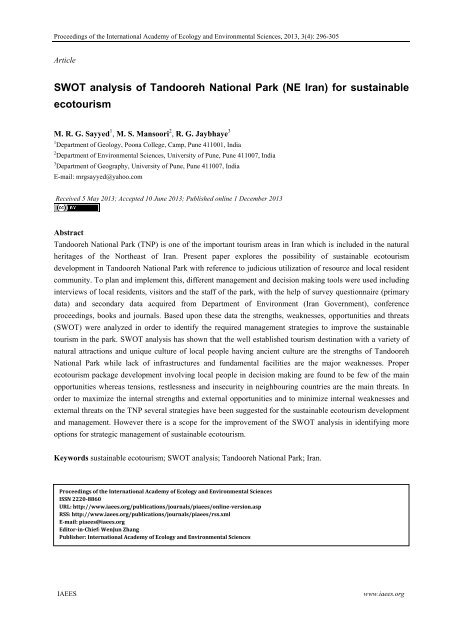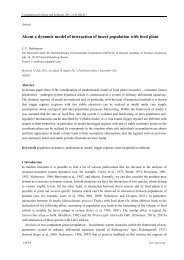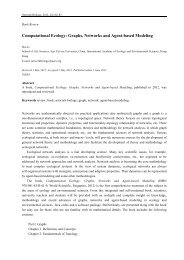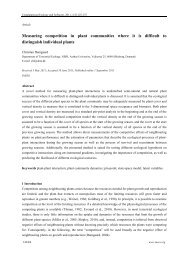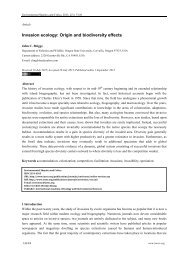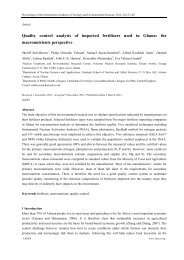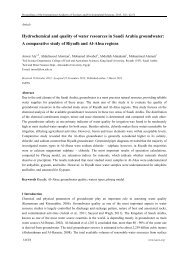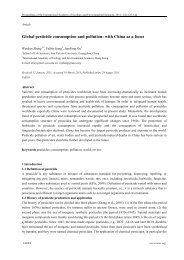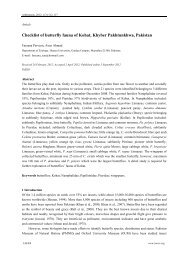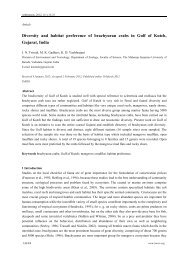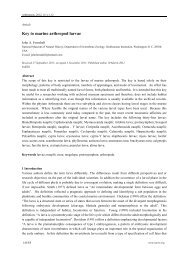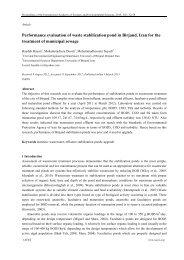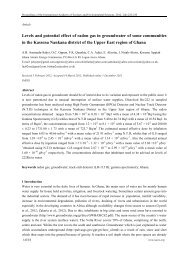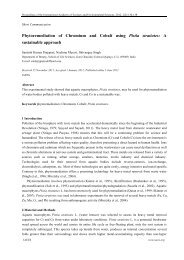SWOT analysis of Tandooreh National Park (NE Iran) for sustainable ...
SWOT analysis of Tandooreh National Park (NE Iran) for sustainable ...
SWOT analysis of Tandooreh National Park (NE Iran) for sustainable ...
You also want an ePaper? Increase the reach of your titles
YUMPU automatically turns print PDFs into web optimized ePapers that Google loves.
Proceedings <strong>of</strong> the International Academy <strong>of</strong> Ecology and Environmental Sciences, 2013, 3(4): 296-305<br />
Article<br />
<strong>SWOT</strong> <strong>analysis</strong> <strong>of</strong> <strong>Tandooreh</strong> <strong>National</strong> <strong>Park</strong> (<strong>NE</strong> <strong>Iran</strong>) <strong>for</strong> <strong>sustainable</strong><br />
ecotourism<br />
M. R. G. Sayyed 1 , M. S. Mansoori 2 , R. G. Jaybhaye 3<br />
1 Department <strong>of</strong> Geology, Poona College, Camp, Pune 411001, India<br />
2 Department <strong>of</strong> Environmental Sciences, University <strong>of</strong> Pune, Pune 411007, India<br />
3 Department <strong>of</strong> Geography, University <strong>of</strong> Pune, Pune 411007, India<br />
E-mail: mrgsayyed@yahoo.com<br />
Received 5 May 2013; Accepted 10 June 2013; Published online 1 December 2013<br />
Abstract<br />
<strong>Tandooreh</strong> <strong>National</strong> <strong>Park</strong> (TNP) is one <strong>of</strong> the important tourism areas in <strong>Iran</strong> which is included in the natural<br />
heritages <strong>of</strong> the Northeast <strong>of</strong> <strong>Iran</strong>. Present paper explores the possibility <strong>of</strong> <strong>sustainable</strong> ecotourism<br />
development in <strong>Tandooreh</strong> <strong>National</strong> <strong>Park</strong> with reference to judicious utilization <strong>of</strong> resource and local resident<br />
community. To plan and implement this, different management and decision making tools were used including<br />
interviews <strong>of</strong> local residents, visitors and the staff <strong>of</strong> the park, with the help <strong>of</strong> survey questionnaire (primary<br />
data) and secondary data acquired from Department <strong>of</strong> Environment (<strong>Iran</strong> Government), conference<br />
proceedings, books and journals. Based upon these data the strengths, weaknesses, opportunities and threats<br />
(<strong>SWOT</strong>) were analyzed in order to identify the required management strategies to improve the <strong>sustainable</strong><br />
tourism in the park. <strong>SWOT</strong> <strong>analysis</strong> has shown that the well established tourism destination with a variety <strong>of</strong><br />
natural attractions and unique culture <strong>of</strong> local people having ancient culture are the strengths <strong>of</strong> <strong>Tandooreh</strong><br />
<strong>National</strong> <strong>Park</strong> while lack <strong>of</strong> infrastructures and fundamental facilities are the major weaknesses. Proper<br />
ecotourism package development involving local people in decision making are found to be few <strong>of</strong> the main<br />
opportunities whereas tensions, restlessness and insecurity in neighbouring countries are the main threats. In<br />
order to maximize the internal strengths and external opportunities and to minimize internal weaknesses and<br />
external threats on the TNP several strategies have been suggested <strong>for</strong> the <strong>sustainable</strong> ecotourism development<br />
and management. However there is a scope <strong>for</strong> the improvement <strong>of</strong> the <strong>SWOT</strong> <strong>analysis</strong> in identifying more<br />
options <strong>for</strong> strategic management <strong>of</strong> <strong>sustainable</strong> ecotourism.<br />
Keywords <strong>sustainable</strong> ecotourism; <strong>SWOT</strong> <strong>analysis</strong>; <strong>Tandooreh</strong> <strong>National</strong> <strong>Park</strong>; <strong>Iran</strong>.<br />
Proceedings <strong>of</strong> the International Academy <strong>of</strong> Ecology and Environmental Sciences<br />
ISSN 22208860<br />
URL: http://www.iaees.org/publications/journals/piaees/onlineversion.asp<br />
RSS: http://www.iaees.org/publications/journals/piaees/rss.xml<br />
Email: piaees@iaees.org<br />
EditorinChief: WenJun Zhang<br />
Publisher: International Academy <strong>of</strong> Ecology and Environmental Sciences<br />
IAEES<br />
www.iaees.org
Proceedings <strong>of</strong> the International Academy <strong>of</strong> Ecology and Environmental Sciences, 2013, 3(4): 296-305<br />
297<br />
1 Introduction<br />
Ecotourism is a travel to delicate, unspoiled and usually protected areas that strives to be low impact and (<strong>of</strong>ten)<br />
small scale. It helps educate the traveler, provides funds <strong>for</strong> conservation, benefits directly the economic<br />
development and political empowerment <strong>of</strong> local communities and fosters respect <strong>for</strong> different cultures and <strong>for</strong><br />
human rights. Ecotourism is very important so that future generations can experience the wonderful<br />
environment we have today (Martha, 2008). In short ecotourism is a small sub-section <strong>of</strong> the tourism industry<br />
catering tourists who wish to visit natural areas to observe wildlife, natural landscapes and traditional cultures.<br />
In other words it is a tool having potential <strong>for</strong> contributing to <strong>sustainable</strong> livelihoods <strong>of</strong> local communities and<br />
conservation <strong>of</strong> natural environments which has been recognized internationally when the United Nation<br />
declared 2002 as the International Year <strong>of</strong> Ecotourism. Two most appropriate definitions <strong>of</strong> ecotourism are<br />
given below:<br />
Ecotourism is "Responsible travel to natural areas that conserves the environment and improves the wellbeing<br />
<strong>of</strong> the local people" (TIES, 1990).<br />
As defined by IUCN (The World Conservation Union) Ecotourism is “environmentally responsible travel<br />
and visitation to relatively undisturbed natural areas, in order to enjoy and appreciate nature (and any<br />
accompanying cultural features both past and present) that promotes conservation, has low negative visitor<br />
impacts, and provides <strong>for</strong> beneficially active socio-economic involvement <strong>of</strong> local people” (Ceballos-<br />
Lascurain, 1996).<br />
Sustainable tourism development integrates environment with development based on the ecological,<br />
economical, social and institutional pillars <strong>of</strong> sustainability. Sustainability <strong>of</strong> the <strong>for</strong>ests has been accepted as<br />
the main principle <strong>of</strong> the <strong>for</strong>estry pr<strong>of</strong>ession <strong>for</strong> a long time and at present (especially after Rio Earth Summit<br />
in 1992) <strong>sustainable</strong> development or <strong>sustainable</strong> resource management has become an attractive idea <strong>for</strong><br />
resource managers (Warner, 1997). In the development <strong>of</strong> the concept <strong>of</strong> <strong>sustainable</strong> development it was<br />
recognized that there was a need to link conservation <strong>of</strong> resources with the development needs <strong>of</strong> rural<br />
population who depend on the resources (Gilmour, 1995). To encompass the social dimensions <strong>of</strong> productive<br />
organization and environmental conservation ecotourism projects must go beyond prevailing notions <strong>of</strong> "the<br />
overlap between nature tourism and <strong>sustainable</strong> tourism". Ecotourism must be beyond creating a series <strong>of</strong><br />
activities to attract visitors, <strong>of</strong>fering them an opportunity to interact with nature in such a way that it should be<br />
possible to preserve or enhance the special qualities <strong>of</strong> the ecotourism site including and its flora and fauna,<br />
while allowing local inhabitants and future visitors to continue to enjoy these qualities. They must also<br />
establish a durable productive base to allow the local inhabitants and ecotourism service providers to enjoy a<br />
<strong>sustainable</strong> standard <strong>of</strong> living while <strong>of</strong>fering these services. Sustainable tourism resources are used in such a<br />
way that these resources <strong>for</strong> future generations do not lose their appeal.<br />
Ecotourism activities are gradually becoming popular in <strong>Iran</strong>. In March 2006, the <strong>Iran</strong> Cultural Heritage,<br />
Handicraft and Tourism Organization (ICHHTO) created the <strong>National</strong> Committee <strong>of</strong> Ecotourism as the first<br />
specialist team focusing on ecotourism. This Committee consists <strong>of</strong> educational, cultural, legal, technical and<br />
ecotourism activists. Beside this main center, twenty nine Provincial Ecotourism Committees were established<br />
representing each province <strong>of</strong> <strong>Iran</strong>. While the development <strong>of</strong> such groups shows positive signs, the provincial<br />
committees are currently not sufficiently staffed with enough fulltime specialists. <strong>Iran</strong>’s <strong>sustainable</strong> ecotourism,<br />
which is dependent on ecology, environment and host communities, is now being widely promoted by<br />
communities and the government. The <strong>Tandooreh</strong> <strong>National</strong> <strong>Park</strong> in <strong>Iran</strong> is appropriate place to investigate the<br />
roles that the <strong>sustainable</strong> ecotourism can per<strong>for</strong>m in visitor’s rewarding experiences, environmental<br />
conservation and the resident’s local culture and way <strong>of</strong> life<br />
IAEES<br />
www.iaees.org
298<br />
Proceedings <strong>of</strong> the International Academy <strong>of</strong> Ecology and Environmental Sciences, 2013, 3(4): 296-305<br />
2 Previous Work<br />
<strong>Iran</strong> has an extraordinary and specific position because <strong>of</strong> the variety <strong>of</strong> climate and weather, cultural richness,<br />
deserts, <strong>for</strong>ests, geomorphological position, national parks, wildlife refuges and extraordinary seas and beaches,<br />
natural landmarks, mountains, pastures, lagoons, lakes and islands (Asadi, 2012) and hence ecotourism can be<br />
the most important competitive advantage <strong>of</strong> <strong>Iran</strong> ecotourism industry. Due to its territorial diversity, historical<br />
and cultural attractions, range <strong>of</strong> diversified handicrafts and a cache <strong>of</strong> biological diversity <strong>Iran</strong> enjoys a<br />
relatively advantageous position in the field <strong>of</strong> eco-tourism as compared to other branches <strong>of</strong> tourism<br />
(Zangiabadi et al., 2006; Tavangar, 2010). Although <strong>Iran</strong> ranks second in the south region <strong>of</strong> Asia in attracting<br />
the greatest number <strong>of</strong> tourists and the revenues in this section are only second to attract India (Ebrahimzadeh<br />
and Aghasizadeh, 2009) <strong>Iran</strong> is not yet an ecotourism destination <strong>for</strong> international visitors as most <strong>of</strong> the travel<br />
is by local people (Tavassoli, 2002) and hence it is essential to identify the important problems and to address<br />
them. In this regards few notable studies on the <strong>sustainable</strong> ecotourism are from Alamut Region (Saeb et al.,<br />
2012), from Boujagh <strong>National</strong> <strong>Park</strong> (Reihanian et al., 2012), from protected areas (Momeni, 2012), from<br />
Northern <strong>for</strong>ests <strong>of</strong> <strong>Iran</strong> (Barzekar et al., 2011), from Eslami Island (Mokhtarshahi et al., 2012), from Qeshm<br />
Island (Jozi et al., 2010) and from Caspian Sea’s South-West Beach (Tabibi et al., 2011).<br />
3 Study Area<br />
Many wonderful contrasts exist in <strong>Iran</strong> owing to its rich variety <strong>of</strong> natural environment. Some <strong>of</strong> them are<br />
listed below.<br />
The temperature in the different parts <strong>of</strong> <strong>Iran</strong> varies between 70°C (in Dasht E Lut) and -36°C in<br />
mountainous areas <strong>of</strong> north and west.<br />
The wide range <strong>of</strong> rainfall also varies from approximately zero in Dasht E Lut to about 2,000mm in Gilan<br />
province.<br />
There are about 10,000 species <strong>of</strong> plants, 516 <strong>of</strong> wild birds and 160 species <strong>of</strong> mammals which<br />
undoubtedly draw the attention <strong>of</strong> every specialist and animal lover.<br />
<strong>Iran</strong> is a vast country and has a lot <strong>of</strong> cultural, natural and historical resources which has resulted in a high<br />
potential to attract tourists, since there are 131 protected areas, including19 national parks, 91 natural reserve,<br />
21 natural parks, 12 world heritage sites and lots <strong>of</strong> attractions with natural or historical importance (Asadi,<br />
2012).<br />
<strong>Tandooreh</strong> <strong>National</strong> <strong>Park</strong> is situated in the north <strong>of</strong> Khorasan province in Dargaz division (Fig. 1) and the<br />
big cities nearby <strong>Tandooreh</strong> national park are Mashhad, Ghochan and Dargaz. This <strong>Park</strong> with 73,435 hectare<br />
area was guarded in 1968 as a <strong>Tandooreh</strong> protected region and in 1969 its names has been changed to<br />
<strong>Tandooreh</strong> Wild <strong>Park</strong>. The park area in 1975 was 53,780 hectare. In 1978 and later <strong>for</strong> many reasons, such as<br />
no possibility <strong>of</strong> region protection, increase <strong>of</strong> cattle number the limits and bounds <strong>of</strong> <strong>Tandooreh</strong> park were<br />
reconsidered and in 1982 the bounds <strong>of</strong> this park was authorized with the area <strong>of</strong> 37,800 hectare by the<br />
supreme board <strong>of</strong> environment protection. This park is also very important as some historical and spiritual<br />
places such as Ghale Rajabe, two shrines <strong>of</strong> Chehelmir and Baba Nastan are situated there.<br />
IAEES<br />
www.iaees.org
Proceedings <strong>of</strong> the International Academy <strong>of</strong> Ecology and Environmental Sciences, 2013, 3(4): 296-305<br />
299<br />
Fig. 1 The geographical location <strong>of</strong> the study area in the world and <strong>Iran</strong>.<br />
4 Materials and Methods<br />
To complete the objectives <strong>of</strong> the study, the primary and secondary data has been collected from different<br />
categories <strong>of</strong> fields, people and institutions involved in promoting ecotourism industries.<br />
The primary data has been collected in the following ways:<br />
• Inspection <strong>of</strong> the field.<br />
• Formal and semi-<strong>for</strong>mal interviews with tourists and local people.<br />
• Use the statistically designed questionnaire to collect the opinions and in<strong>for</strong>mation from the local<br />
residents, tourists and the staff <strong>of</strong> the <strong>Park</strong>.<br />
• <strong>SWOT</strong> Analysis <strong>for</strong> defining the strategies.<br />
The secondary data has been collected during different stage <strong>of</strong> work.<br />
In September 2011 the residents from two villages viz. Doodanlou and Taj Aldin near the city <strong>of</strong> Dargaz,<br />
were selected <strong>for</strong> interviewing because <strong>of</strong> their familiarity with the <strong>Tandooreh</strong> <strong>National</strong> <strong>Park</strong>. Interview<br />
questionnaires (consisting <strong>of</strong> 12 questions) were translated in Persian (local language) and after getting the<br />
answers from the villagers they were retranslated into English <strong>for</strong> further processing. The tourists were also<br />
given a separate questionnaire (consisting <strong>of</strong> 23 questions) and they were interviewed <strong>for</strong> a period <strong>of</strong> one<br />
month (between September and October, 2011) as this period was end <strong>of</strong> summer and beginning <strong>of</strong> fall season<br />
and this time is the best season to visit the <strong>Park</strong>. Questionnaires (consisting <strong>of</strong> 10 questions) were also<br />
distributed to the staff <strong>of</strong> the park from five monitoring stations. After collecting the questionnaire the data<br />
obtained were analyzed using the computer s<strong>of</strong>twares like excel to determine the satisfaction index, opinion<br />
index etc. and also chi square <strong>analysis</strong>. The outline <strong>of</strong> the research methodology adopted in the present work is<br />
illustrated in Fig. 2.<br />
IAEES<br />
www.iaees.org
300<br />
Proceedings <strong>of</strong> the International Academy <strong>of</strong> Ecology and Environmental Sciences, 2013, 3(4): 296-305<br />
Resident<br />
Survey<br />
Visitor<br />
Survey<br />
Staff<br />
Survey<br />
Data<br />
Collection<br />
DOE, Journal,<br />
Conferences,<br />
Books, etc.<br />
Conservation,<br />
Management,<br />
Sustainable Tourism<br />
Primary<br />
Data<br />
<strong>SWOT</strong><br />
Analysis<br />
Secondary<br />
Data<br />
CONCLUSIONS<br />
Fig. 2 Outline <strong>of</strong> the research methodology adopted.<br />
5 <strong>SWOT</strong> (Strength – Weakness – Opportunity – Threat) Analysis<br />
Surveying internal and external environment is an important part <strong>of</strong> the strategic planning. Internal factors can<br />
be classified as strengths (S) or weaknesses (W) and external factors can be classified as opportunities (O) or<br />
threats (T). The <strong>SWOT</strong> <strong>analysis</strong> helps in analyzing the advantages and disadvantages <strong>of</strong> the ecotourism and<br />
coming out with strategic suggestions <strong>for</strong> ecotourism planning. This also helps in sound understanding <strong>of</strong><br />
elements, process and practice <strong>of</strong> local institutions in order to determine appropriate interventions. Following<br />
that, strategic alternatives are selected in the light <strong>of</strong> the strengths, weaknesses, threats and opportunities as<br />
determined through internal and external environment <strong>analysis</strong> (Yuksel and Dagdeviren, 2007) <strong>SWOT</strong> <strong>analysis</strong><br />
is intended to maximize strengths and opportunities, minimize external threats, trans<strong>for</strong>m weaknesses into<br />
strengths and to take advantage <strong>of</strong> opportunities along with minimizing both internal weaknesses and external<br />
threats (Saaty, 1987).<br />
6 Results<br />
After primary and secondary data collection <strong>SWOT</strong> <strong>analysis</strong> was per<strong>for</strong>med to assess the feasibility <strong>of</strong><br />
<strong>sustainable</strong> tourism in <strong>Tandooreh</strong> <strong>National</strong> <strong>Park</strong> through analyzing the results and determining the priorities.<br />
Method <strong>of</strong> <strong>SWOT</strong> Analysis: Although <strong>SWOT</strong> <strong>analysis</strong> (Strengths, Weaknesses, Opportunities, and Threats)<br />
research method is <strong>of</strong>ten used in business fields it has now been extended to natural resource management to<br />
assess the decision and policy directive in a systematic manner (Schmoldt et al., 2001) and also in an<br />
assessment <strong>of</strong> <strong>sustainable</strong> tourism (NOAA, 2011). The strengths and weaknesses (local <strong>analysis</strong>) are the<br />
internal factors while opportunities and threats (global <strong>analysis</strong>) are external factors (Harfst et al., 2010).<br />
Evaluation <strong>of</strong> internal and external environmental factors is an important part <strong>of</strong> strategic planning which is<br />
IAEES<br />
www.iaees.org
Proceedings <strong>of</strong> the International Academy <strong>of</strong> Ecology and Environmental Sciences, 2013, 3(4): 296-305<br />
301<br />
instrumental in adopting the strategies and becomes a component <strong>of</strong> <strong>sustainable</strong> ecotourism management. In<br />
this study the <strong>SWOT</strong> <strong>analysis</strong> was conducted on the <strong>Tandooreh</strong> <strong>National</strong> <strong>Park</strong> in order to assess the<br />
sustainability <strong>of</strong> ecotourism development. In this process the internal factors (strengths and weaknesses) and<br />
external factors (opportunities and threats) were identified and listed. For evaluation <strong>of</strong> internal and external<br />
factors internal factor estimate matrix (IFEM) and external factor estimate matrix (IEEM) were used. IFEM<br />
represents internal strengths and weaknesses while EFEM indicate external opportunities and threats. In<br />
<strong>for</strong>mulating the matrices each factor was evaluated by giving a weight between zero (non important) to one<br />
(most important) such a way that the total point in ach matrix is unity. Further each factor was scored with a<br />
number between one and five (1 = poor; 2 = lower than average; 3 = median; 4 = above average and 5 = good).<br />
After the weight and score have been determined the weighted score has been given to each factor which is<br />
useful in assessing the attractiveness <strong>of</strong> each factor. In IFEM the total <strong>of</strong> weighted scores (attractiveness) with<br />
a value more than 2.5 indicate strengths are more than weaknesses. Similarly in case <strong>of</strong> EFEM the total <strong>of</strong><br />
weighted scores with a value more than 2.5 means opportunities are more than strengths (Monavari et al.,<br />
2007).<br />
Weighted score <strong>for</strong> the strengths and weaknesses (IFEM) and <strong>for</strong> the opportunities and threats (EFEM) are<br />
tabulated in Tables 1 and 2 respectively.<br />
Table 1 Weighted Score <strong>for</strong> the strengths and weaknesses (Internal factor estimate matrix; IFEM).<br />
Strengths Weight Score Weighted<br />
Score<br />
1 <strong>Tandooreh</strong> <strong>National</strong> <strong>Park</strong> is a well established tourism destination with a variety <strong>of</strong> 0.1190 4 0.4762<br />
natural attractions like the Cheetah, Wild goat, Wild ship etc, unique culture <strong>of</strong> local<br />
people having ancient culture; magnificent local language and historical holy Shrine.<br />
2 The local people strongly supporting the need <strong>of</strong> ecotourism in this region as good 0.0779 3 0.2338<br />
number <strong>of</strong> domestic tourists visit this destination.<br />
3 The region has good weather and climate, unique ecosystem, great biodiversity and 0.0606 3 0.1818<br />
valuable wildlife.<br />
4 The existence <strong>of</strong> a large number <strong>of</strong> protected areas (national, natural parks and 0.0844 2 0.1688<br />
reservations) included in the Fourth <strong>National</strong> Report to the Convention on Biological<br />
Diversity (2010) with reduced pollution in the majority <strong>of</strong> rural areas;<br />
5 Variety and ethnic richness in indigenous areas with traditional cuisine and regional 0.0519 4 0.2078<br />
specialties;<br />
6 Much incentive <strong>for</strong> the local people from tourism in terms <strong>of</strong> income generation. 0.0649 3 0.1948<br />
Weaknesses<br />
1 Lack <strong>of</strong> coordination among local people and low involvement <strong>of</strong> local people in 0.0758 3 0.2273<br />
tourism.<br />
2 Lack <strong>of</strong> infrastructures and fundamental facilities like accommodation (hotels and 0.0866 4 0.3463<br />
resorts), travel and ecotourism agencies, public transport, recreation.<br />
3 The lack <strong>of</strong> <strong>for</strong>eign tourists; 0.0498 2 0.0996<br />
4 The lack <strong>of</strong> strategies that ensure the promotion and marketing <strong>of</strong> ecotourism in the 0.0628 3 0.1883<br />
protected areas.<br />
5 Seasonality <strong>of</strong> ecotourism and unequal distribution <strong>of</strong> tourism 0.0996 3 0.2987<br />
6 High rate <strong>of</strong> inflation and unsuitable domestic economy which hardens the development 0.0714 5 0.3571<br />
<strong>of</strong> ecotourism and increases the expense <strong>of</strong> travel;<br />
7 Absence <strong>of</strong> strict rules <strong>for</strong> entering the <strong>Tandooreh</strong> <strong>National</strong> <strong>Park</strong> as there is absence <strong>of</strong><br />
proper zoning and border fencing around the park parameter<br />
0.0563 3 0.1688<br />
8 Lack <strong>of</strong> adequate funding <strong>for</strong> conservation and scientific research and education in the 0.0390 2 0.0779<br />
region<br />
Total 1.0000 ----- 3.2273<br />
IAEES<br />
www.iaees.org
302<br />
Proceedings <strong>of</strong> the International Academy <strong>of</strong> Ecology and Environmental Sciences, 2013, 3(4): 296-305<br />
Table 2 Weighted Score <strong>for</strong> the opportunities and threats (External factor estimate matrix; EFEM).<br />
Opportunities Weight Score Weighted<br />
Score<br />
1 Proper ecotourism package development involving local people in decision making 0.1027 5 0.5137<br />
and planning so that there is a larger involvement <strong>of</strong> the local people.<br />
2 Diversification <strong>of</strong> ecotourism products which will help in retaining majority <strong>of</strong> the 0.0514 2 0.1027<br />
income generated with the local people which will help in job creation directly<br />
benefiting the local community<br />
3 Conserving natural ecosystems and making ef<strong>for</strong>t to decrease negative impacts 0.0428 4 0.1712<br />
4 Feasibility <strong>of</strong> implementing tourism plans in <strong>Tandooreh</strong> <strong>National</strong> <strong>Park</strong>, considering 0.0514 3 0.1541<br />
environmental requirements with emphasis on conserving native culture and<br />
prevention <strong>of</strong> the traditional context alteration.<br />
5 High international interest <strong>for</strong> ecotourism, agrotourism, rural tourism, adventure 0.0394 4 0.1575<br />
tourism;<br />
6 The climate, with s<strong>of</strong>t summers and cold spring, favorable <strong>for</strong> the tourist activity 0.0462 2 0.0925<br />
during the year;<br />
7 Possibility to attract tourists by exploiting historical, cultural, spiritual and traditional 0.0616 3 0.1849<br />
inheritance;<br />
8 The existence <strong>of</strong> the legislative framework which allows the conservation <strong>of</strong> the 0.0497 2 0.0993<br />
protected areas.<br />
9 Existence <strong>of</strong> a considerable number <strong>of</strong> potential tourists like <strong>Iran</strong>ian settled in 0.0308 1 0.0308<br />
Western countries and neighbor and Islamic countries which have historical, religious<br />
and cultural relations with <strong>Iran</strong>.<br />
10 Geographical position <strong>of</strong> this country (Closeness to tourist generating countries). 0.0257 2 0.0514<br />
11 Satisfaction <strong>of</strong> tourists after visiting <strong>Tandooreh</strong> <strong>National</strong> <strong>Park</strong>. 0.0771 5 0.3853<br />
12 The basic infrastructure <strong>of</strong> utilities are satisfactory 0.0942 3 0.2825<br />
Threats<br />
1 Potential negative cultural and environmental impacts with lack <strong>of</strong> favorable 0.0719 3 0.2158<br />
circumstances <strong>for</strong> <strong>for</strong>eign tourists, intensification <strong>of</strong> the economical crisis and<br />
instability <strong>of</strong> the national currency;<br />
2 Transport infrastructure not to the community standards and emergency medical 0.0616 4 0.2466<br />
services are unsatisfactory.<br />
3 Presentation <strong>of</strong> an unsuitable image <strong>of</strong> <strong>Iran</strong> in International societies to international 0.0942 2 0.1884<br />
tourists.<br />
4 Tensions, restlessness and insecurity in Middle East and especially in neighbouring 0.0993 4 0.3973<br />
countries like Afghanistan and Iraq, which causes the number <strong>of</strong> international tourists<br />
to decrease.<br />
Total 1.0000 ----- 3.2740<br />
Internal factor estimate matrix (IFEM): Regarding strengths six factors were identified (Table I). The<br />
weights allocated <strong>for</strong> these factors were between 0.0519 and 0.1190 and the score ranged between 2 to 4.<br />
When considering weaknesses 8 factors were detected with highest weight <strong>of</strong> 0.0996 and lowest weight <strong>of</strong><br />
0.0390 with score ranging between 2 to 4. The final weighted score was 3.227 implying that strengths were<br />
more than weaknesses.<br />
External factor estimate matrix (EFEM): There were 12 factors pertaining to opportunities (Table II) with<br />
weights between 0.0257 and 0.1027 and scores between 1 and 5. There were 4 treats determined with lowest<br />
weight <strong>of</strong> 0.0616 and highest <strong>of</strong> 0.0993 and sores between 2 to 4. The final weighed score was 3.274 indicating<br />
opportunities were more than threats.<br />
7 Conclusions<br />
Sustainable tourism is the main pivot <strong>for</strong> <strong>Tandooreh</strong> <strong>National</strong> <strong>Park</strong> and to achieve this pair wise matching (SO,<br />
WO, ST, and WT) has been done. The incidence point <strong>of</strong> the internal and external factors <strong>of</strong> <strong>Tandooreh</strong><br />
IAEES<br />
www.iaees.org
Proceedings <strong>of</strong> the International Academy <strong>of</strong> Ecology and Environmental Sciences, 2013, 3(4): 296-305<br />
303<br />
<strong>National</strong> <strong>Park</strong> ecotourism (Fig. 3) clearly point towards strong internal factor estimate while high potential <strong>of</strong><br />
ecotourism is suggested from external factor estimate<br />
Fig. 3 The incidence point <strong>of</strong> the internal and external factors.<br />
Thus by comparing internal and external factors in the matrix <strong>of</strong> strengths, weaknesses, opportunities and<br />
threats (<strong>SWOT</strong>) acceptable strategies were <strong>for</strong>mulated which are as follows.<br />
S-O strategies: Proposed opportunities that fit well with the park's strengths are<br />
1. Establishment <strong>of</strong> welfare places and hotels <strong>for</strong> ecotourism in the region which will help in creating jobs to<br />
the local people<br />
2. The use <strong>of</strong> regional potentials <strong>for</strong> conservation <strong>of</strong> natural ecosystem.<br />
3. Developing new geographical markets especially attracting ecotourism from tourist generating markets.<br />
4. Develop minimal entrance fee plan to improve the basic facilities.<br />
5. Developing tourism products with emphasis on ecotourism attractions by promoting quality services and<br />
products<br />
S-T strategies: Following strategies have been identified by which the strengths can be used to reduce its<br />
vulnerability to the external threats.<br />
1. To avoid negative impacts <strong>of</strong> tourism on sensitive biodiversity a particular plan should be developed to<br />
conserve the ecology in accordance with national and international lists such as IUCN (2012) red list and DOE<br />
(2011) list <strong>of</strong> protected species.<br />
2. Establishing facilities and conditions required to attract <strong>for</strong>eign tourists so that the image <strong>of</strong> <strong>Iran</strong> is<br />
improved.<br />
3. Increasing environmental guard stations and patrols to improve conservational capacity.<br />
4. Law en<strong>for</strong>cement <strong>for</strong> the illegal hunters and impose heavy financial penalties <strong>for</strong> noncompliance<br />
5. Sustainable development <strong>of</strong> ecotourism region by renovating and developing ecotourism corridors.<br />
IAEES<br />
www.iaees.org
304<br />
Proceedings <strong>of</strong> the International Academy <strong>of</strong> Ecology and Environmental Sciences, 2013, 3(4): 296-305<br />
W-O strategies: The strategies which can be used to overcome weaknesses by pursuing opportunities are<br />
1. Increase research funding <strong>for</strong> scientific studies and research in the area to decrease negative impacts.<br />
2. Facilitating the tours operated by tour operators with collaboration <strong>of</strong> the authorities and local people.<br />
3. Establishment <strong>of</strong> well equipped wild life-watching site in different locations in the park.<br />
4. Attracting ecotourism throughout the year by holding ecotourism festivals in the areas which have<br />
different weather, climate and culture.<br />
5. Integration <strong>of</strong> solid waste management plan into environmental education and planning <strong>of</strong> solid waste<br />
rules and regulations <strong>for</strong> visitors.<br />
W-T strategies: To establish a defensive plan to prevent the park's weaknesses from making it highly<br />
susceptible to the external threats following strategies have been suggested.<br />
1. Infrastructure development harmonized with population increase caused by tourist visits<br />
2. Environmental education to the building contractors and tour operators in reducing the environmental<br />
impacts.<br />
3. Investing to improve the quality <strong>of</strong> infrastructures, such as road transport systems, hospitality and<br />
accommodation centers, medical and health services, increasing access to new technologies, such as Internet,<br />
telephone, post, guiding s<strong>of</strong>tware and so on in ecotourism regions<br />
4. Developing international collaborative activities to receive support in the field <strong>of</strong> research and<br />
development related to <strong>sustainable</strong> ecotourism.<br />
References<br />
Asadi R. 2012. Strategies <strong>for</strong> <strong>Iran</strong> ecotourism. World Applied Sciences Journal, 18 (3): 414-424<br />
Barzekar G, Aziz A, Mariapan M, et al. 2011. Delphi technique <strong>for</strong> generating criteria and indicators in<br />
monitoring ecotourism sustainability in Northern <strong>for</strong>ests <strong>of</strong> <strong>Iran</strong>: Case study on Dohezar and Sehezar<br />
Watersheds. Forestalia Polonica Series A, 53(2): 130-141<br />
Ceballos-Lascurain H. 1996. Tourism, Ecotourism and Protected Areas. IUCN. The World Conservation<br />
Union. Gland, Switzerland<br />
DOE. 2011. Protected areas in <strong>Iran</strong>. http://www.doe.ir/portal/Home/Default. aspx?CategoryID=194f31a0-<br />
4030-446f-8a8a-3b49774ba52d. Accessed Feb, 2011<br />
Ebrahimzade E, Aghasizade A. 2009. Analysis <strong>of</strong> factors affecting tourism in Chabahar coastal area by using<br />
the <strong>SWOT</strong> strategic. Urban Studies and Research and Regional, <strong>Iran</strong>, 1(1): 107-128<br />
Gilmour DA. 1995. Conservation and development: seeking the linkages. Community development and<br />
conservation <strong>of</strong> <strong>for</strong>est biodiversity through community <strong>for</strong>estry. Proceedings <strong>of</strong> an International Seminar,<br />
Bangkok, Thailand<br />
Harfst J, Wirth P, Lintz, G, Bieberstein,C. 2010. Strengths, Weaknesses, Opportunities and Threats <strong>of</strong><br />
European mining regions (<strong>SWOT</strong> Report I). Leibniz Institute <strong>of</strong> Ecological and Regional Development<br />
(IOER), Dresden, Germany<br />
IUCN. 2012. The IUCN Red List <strong>of</strong> Threatened Species. Version 2012.2. http://www.iucnredlist.org<br />
Jozi SA, Aghapour P, Khalilzadeh Poshtegal. M, et al. 2010. Presentation <strong>of</strong> strategic management plan in<br />
ecotourism development through <strong>SWOT</strong>: Case study <strong>of</strong> Qeshm Island. Journal <strong>of</strong> Food, Agriculture and<br />
Environment, 8(2): 1123-1132<br />
Martha H. 2008. Ecotourism and Sustainable Development: Who Owns Paradise? Island Press, USA<br />
Mokhtarshahi Sani R, Mahasti P. 2012. Regenerating regional identity <strong>for</strong> <strong>sustainable</strong> tourism development<br />
case study, Eslami Island, <strong>Iran</strong>. Procedia - Social and Behavioral Sciences, 35: 523-530<br />
IAEES<br />
www.iaees.org
Proceedings <strong>of</strong> the International Academy <strong>of</strong> Ecology and Environmental Sciences, 2013, 3(4): 296-305<br />
305<br />
Momeni M. 2012. <strong>Iran</strong>'s role in the development <strong>of</strong> ecotourism and <strong>sustainable</strong> development <strong>of</strong> protected areas.<br />
American Journal <strong>of</strong> Scientific Research, 50: 112-118<br />
Monavari M, Karbasi A, Mogooee R. 2007. Environmental Strategic Management. Kavoush Qalam, Tehran,<br />
<strong>Iran</strong><br />
NOAA. 2011. Assessment <strong>for</strong> <strong>sustainable</strong> tourism. http://sanctuaries.noaa.gov/<br />
management/international/pdfs/day2_assessment_manual.pdf. Accessed Nov 2011<br />
Reihanian A, Noor ZM, Kahrom E, et al. 2012. Sustainable tourism development strategy by <strong>SWOT</strong><br />
<strong>analysis</strong>: Boujagh <strong>National</strong> <strong>Park</strong>, <strong>Iran</strong>. Tourism Management Perspectives, 4: 223-228<br />
Saaty RW. 1987. The analytic hierarchy process and <strong>SWOT</strong> <strong>analysis</strong>–what it is and how it is used.<br />
Mathematical Modeling, 9: 161-178<br />
Saeb K, Jafari Hajati R, Rezai S. 2012. An investigation into eco-tourism potential <strong>of</strong> the Alamut region <strong>of</strong><br />
<strong>Iran</strong> using <strong>SWOT</strong> <strong>analysis</strong> model. Ecologia Balkanica, 4(1): 9-20<br />
Schmoldt D, Kangas J, Mendoza G, et al. 2001. The Analytic Hierarchy Process in Natural Resource and<br />
Environmental Decision Making. Springer, The Netherlands<br />
Tabibi M, Rohani A. 2011. Jet Ski development strategies: the case <strong>of</strong> Caspian Sea’s south-west beach.<br />
Tourismos: An International Multidisciplinary Journal <strong>of</strong> Tourism, 6(2): 175-192<br />
Tavangar M. 2010. Importance <strong>of</strong> Sistan and Baluchestan Ecotourism. Affiliation, Urban planning Department<br />
<strong>Iran</strong>ian Academic Center <strong>for</strong> Education Culture and Research. Mashhad, <strong>Iran</strong><br />
Tavassoli K. 2002. Ecotourism in <strong>Iran</strong>: In: Linking Green Productivity to Ecotourism (Chapter 12: Ecotourism<br />
in <strong>Iran</strong>) (Tundloe T, ed). Asian Productivity Organization, Tokyo, Japan<br />
TIES. 1990. TIES’ definition <strong>of</strong> ecotourism. www.ecotourism.org<br />
Warner K. 1997. The vision and role <strong>of</strong> community <strong>for</strong>estry in <strong>sustainable</strong> development. Proceedings <strong>of</strong> the XI<br />
World Forestry Congress Vol. 5.<br />
Yuksel I, Dagdeviren M. 2007. Using the Analytic Network Process (ANP) in a <strong>SWOT</strong> <strong>analysis</strong>-A case study<br />
<strong>for</strong> a textile firm. In<strong>for</strong>mation Science, 177: 3364-3382<br />
Zangiabadi A, Mohamadi J, Zirakbash D. 2006. The <strong>analysis</strong> <strong>of</strong> domestic tourism <strong>of</strong> Isfahan city. Journal <strong>of</strong><br />
Geography and Development, <strong>Iran</strong>, 4(8): 463-470<br />
IAEES<br />
www.iaees.org


